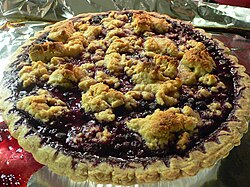 | |
| Type | Pie |
|---|---|
| Course | Dessert |
| Place of origin | United States, Canada |
| Serving temperature | Hot or cold |
| Main ingredients | Blueberries, pie crust, sugar, corn starch |
| Nutritional value per 100 g (3.5 oz) | |||||||||||||||||||||||||||||||||||||||||||||||
|---|---|---|---|---|---|---|---|---|---|---|---|---|---|---|---|---|---|---|---|---|---|---|---|---|---|---|---|---|---|---|---|---|---|---|---|---|---|---|---|---|---|---|---|---|---|---|---|
| Energy | 232 kJ (55 kcal) | ||||||||||||||||||||||||||||||||||||||||||||||
35 g | |||||||||||||||||||||||||||||||||||||||||||||||
10 g | |||||||||||||||||||||||||||||||||||||||||||||||
1.8 g | |||||||||||||||||||||||||||||||||||||||||||||||
| |||||||||||||||||||||||||||||||||||||||||||||||
| Other constituents | Quantity | ||||||||||||||||||||||||||||||||||||||||||||||
| Water | 52.5 g | ||||||||||||||||||||||||||||||||||||||||||||||
| †Percentages estimated using US recommendations for adults, [1] except for potassium, which is estimated based on expert recommendation from the National Academies [2] | |||||||||||||||||||||||||||||||||||||||||||||||
Blueberry pie is a pie with a blueberry filling. Blueberry pie is readily made because it does not require pitting or peeling of fruit. It usually has a top and bottom crust. The top crust can be circular, but the pie can also have a crumble crust or no top crust. Blueberry pies are often eaten in the summertime when blueberries are in season in the Northern Hemisphere. [3]



